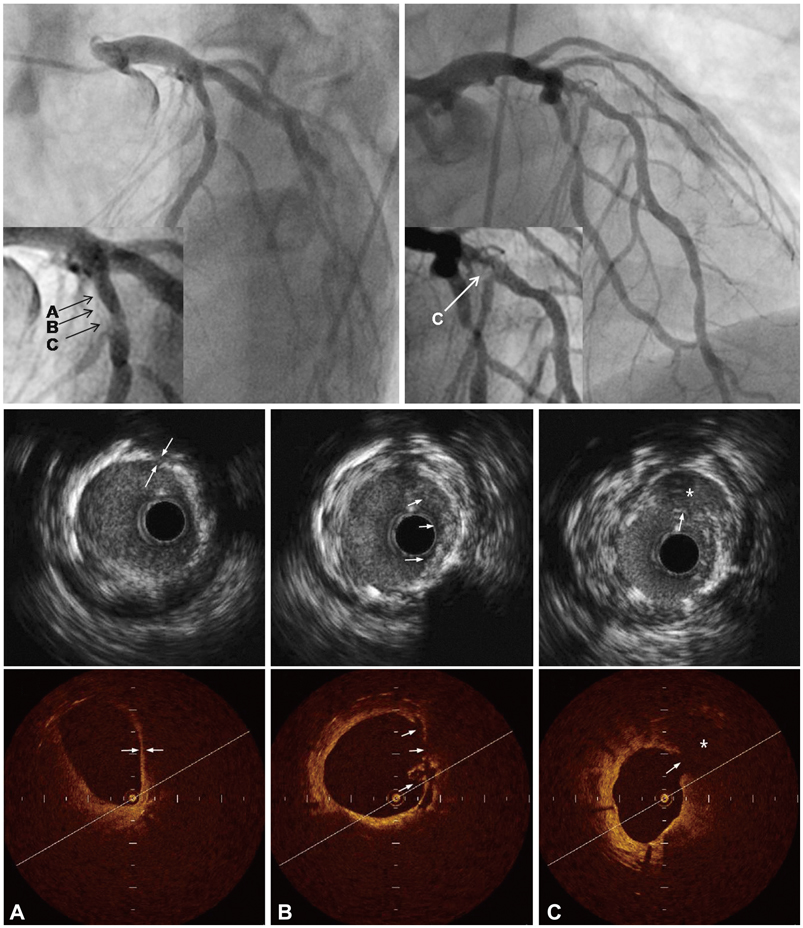Korean Circ J.
2011 Nov;41(11):671-673. 10.4070/kcj.2011.41.11.671.
A Case of In-Stent Neointimal Plaque Rupture 10 Years After Bare Metal Stent Implantation: Intravascular Ultrasound and Optical Coherence Tomographic Findings
- Affiliations
-
- 1Division of Cardiology, Department of Internal Medicine, Keimyung University Dongsan Medical Center, Daegu, Korea. shur@dsmc.or.kr
- KMID: 2225076
- DOI: http://doi.org/10.4070/kcj.2011.41.11.671
Abstract
- Neointimal hyperplasia mainly develops within several months of coronary stent deployment, after which it stabilizes. Although it was widely accepted, particularly during the bare-metal stent (BMS) era, that in-stent restenosis (ISR) generally does not present as an acute coronary syndrome (ACS), but rather as a gradual recurrence of angina symptoms, recent data have shown that a substantial number of patients with ISR present as ACS. There has also been consistent postmortem evidence of plaque rupture secondary to atherosclerotic change within the neointima of a BMS. We report here a case of ACS in which intravascular ultrasound and optical coherent tomographic assessments revealed neointimal atherosclerotic change and ruptured plaque 10 years after BMS deployment.
Keyword
MeSH Terms
Figure
Reference
-
1. Chen MS, John JM, Chew DP, Lee DS, Ellis SG, Bhatt DL. Bare metal stent restenosis is not a benign clinical entity. Am Heart J. 2006. 151:1260–1264.2. Doyle B, Rihal CS, O'Sullivan CJ, et al. Outcomes of stent thrombosis and restenosis during extended follow-up of patients treated with bare-metal coronary stents. Circulation. 2007. 116:2391–2398.3. Fineschi M, Carrera A, Gori T. Atheromatous degeneration of the neointima in a bare metal stent: intravascular ultrasound evidence. J Cardiovasc Med (Hagerstown). 2009. 10:572–573.4. Baek EK, Park SH, Kwon KH, Shim EJ, Jo JY. A case of in-stent plaque rupture presenting as an acute myocardial infarction. Korean Circ J. 2008. 38:432–435.5. Kume T, Akasaka T, Kawamoto T, et al. Assessment of coronary arterial plaque by optical coherence tomography. Am J Cardiol. 2006. 97:1172–1175.6. Jang IK, Bouma BE, Kang DH, et al. Visualization of coronary atherosclerotic plaques in patients using optical coherence tomography: comparison with intravascular ultrasound. J Am Coll Cardiol. 2002. 39:604–609.7. Komatsu R, Ueda M, Naruko T, Kojima A, Becker AE. Neointimal tissue response at sites of coronary stenting in humans: macroscopic, histological, and immunohistochemical analyses. Circulation. 1998. 98:224–233.8. Sangiorgi G, Taylor AJ, Farb A, et al. Histopathology of postpercutaneous transluminal coronary angioplasty remodeling in human coronary arteries. Am Heart J. 1999. 138:681–687.9. Chung IM, Gold HK, Schwartz SM, Ikari Y, Reidy MA, Wight TN. Enhanced extracellular matrix accumulation in restenosis of coronary arteries after stent deployment. J Am Coll Cardiol. 2002. 40:2072–2081.10. Lee CW, Kang SJ, Park DW, et al. Intravascular ultrasound findings in patients with very late stent thrombosis after either drug-eluting or bare-metal stent implantation. J Am Coll Cardiol. 2010. 55:1936–1942.11. Nakazawa G, Otsuka F, Nakano M, et al. The pathology of neoatherosclerosis in human coronary implants bare-metal and drug-eluting stents. J Am Coll Cardiol. 2011. 57:1314–1322.
- Full Text Links
- Actions
-
Cited
- CITED
-
- Close
- Share
- Similar articles
-
- Identification of Vulnerable Plaque in a Stented Coronary Segment 17 Years after Implantation Using Optical Coherence Tomography
- A Case of In-Stent Plaque Rupture Presenting as an Acute Myocardial Infarction
- A Newly Formed and Ruptured Atheromatous Plaque within Neointima after Drug-Eluting Stent Implantation: 2-Year Follow-Up Intravascular Ultrasound and Optical Coherence Tomography Studies
- Stent Evaluation with Optical Coherence Tomography
- Intravascular imaging analysis of a drug-eluting balloon followed by a bare metal stent compared to a drug-eluting stent for treatment of de novo lesions


